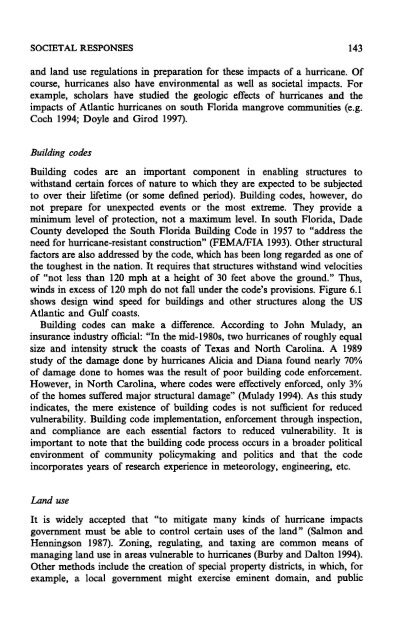Hurricanes: Their Nature and Impacts on Society - Climate Science ...
Hurricanes: Their Nature and Impacts on Society - Climate Science ...
Hurricanes: Their Nature and Impacts on Society - Climate Science ...
Create successful ePaper yourself
Turn your PDF publications into a flip-book with our unique Google optimized e-Paper software.
SOCIETAL RESPONSES 143<br />
<str<strong>on</strong>g>and</str<strong>on</strong>g> l<str<strong>on</strong>g>and</str<strong>on</strong>g> use regulati<strong>on</strong>s in preparati<strong>on</strong> for these impacts of a hurricane. Of<br />
course, hurricanes also have envir<strong>on</strong>mental as well as societal impacts. For<br />
example, scholars have studied the geologic effects of hurricanes <str<strong>on</strong>g>and</str<strong>on</strong>g> the<br />
impacts of Atlantic hurricanes <strong>on</strong> south Florida mangrove communities (e.g.<br />
Coch 1994; Doyle <str<strong>on</strong>g>and</str<strong>on</strong>g> Girod 1997).<br />
Building codes<br />
Building codes are an important comp<strong>on</strong>ent in enabling structures to<br />
withst<str<strong>on</strong>g>and</str<strong>on</strong>g> certain forces of nature to which they are expected to be subjected<br />
to over their lifetime (or some defined period). Building codes, however, do<br />
not prepare for unexpected events or the most extreme. They provide a<br />
minimum level of protecti<strong>on</strong>, not a maximum level. In south Florida, Dade<br />
County developed the South Florida Building Code in 1957 to "address the<br />
need for hurricane-resistant c<strong>on</strong>structi<strong>on</strong>" (FEMA/FIA 1993). Other structural<br />
factors are also addressed by the code, which has been l<strong>on</strong>g regarded as <strong>on</strong>e of<br />
the toughest in the nati<strong>on</strong>. It requires that structures withst<str<strong>on</strong>g>and</str<strong>on</strong>g> wind velocities<br />
of "not less than 120 mph at a height of 30 feet above the ground." Thus,<br />
winds in excess of 120 mph do not fall under the code's provisi<strong>on</strong>s. Figure 6.1<br />
shows design wind speed for buildings <str<strong>on</strong>g>and</str<strong>on</strong>g> other structures al<strong>on</strong>g the US<br />
Atlantic <str<strong>on</strong>g>and</str<strong>on</strong>g> Gulf coasts.<br />
Building codes can make a difference. According to John Mulady, an<br />
insurance industry official: "In the mid-1980s, two hurricanes of roughly equal<br />
size <str<strong>on</strong>g>and</str<strong>on</strong>g> intensity struck the coasts of Texas <str<strong>on</strong>g>and</str<strong>on</strong>g> North Carolina. A 1989<br />
study of the damage d<strong>on</strong>e by hurricanes Alicia <str<strong>on</strong>g>and</str<strong>on</strong>g> Diana found nearly 70%<br />
of damage d<strong>on</strong>e to homes was the result of poor building code enforcement.<br />
However, in North Carolina, where codes were effectively enforced, <strong>on</strong>ly 3%<br />
of the homes suffered major structural damage" (Mulady 1994). As this study<br />
indicates, the mere existence of building codes is not sufficient for reduced<br />
vulnerability. Building code implementati<strong>on</strong>, enforcement through inspecti<strong>on</strong>,<br />
<str<strong>on</strong>g>and</str<strong>on</strong>g> compliance are each essential factors to reduced vulnerability. It is<br />
important to note that the building code process occurs in a broader political<br />
envir<strong>on</strong>ment of community policymaking <str<strong>on</strong>g>and</str<strong>on</strong>g> politics <str<strong>on</strong>g>and</str<strong>on</strong>g> that the code<br />
incorporates years of research experience in meteorology, engineering, etc.<br />
L<str<strong>on</strong>g>and</str<strong>on</strong>g> use<br />
It is widely accepted that "to mitigate many kinds of hurricane impacts<br />
government must be able to c<strong>on</strong>trol certain uses of the l<str<strong>on</strong>g>and</str<strong>on</strong>g>" (Salm<strong>on</strong> <str<strong>on</strong>g>and</str<strong>on</strong>g><br />
Hennings<strong>on</strong> 1987). Z<strong>on</strong>ing, regulating, <str<strong>on</strong>g>and</str<strong>on</strong>g> taxing are comm<strong>on</strong> means of<br />
managing l<str<strong>on</strong>g>and</str<strong>on</strong>g> use in areas vulnerable to hurricanes (Burby <str<strong>on</strong>g>and</str<strong>on</strong>g> Dalt<strong>on</strong> 1994).<br />
Other methods include the creati<strong>on</strong> of special property districts, in which, for<br />
example, a local government might exercise eminent domain, <str<strong>on</strong>g>and</str<strong>on</strong>g> public














